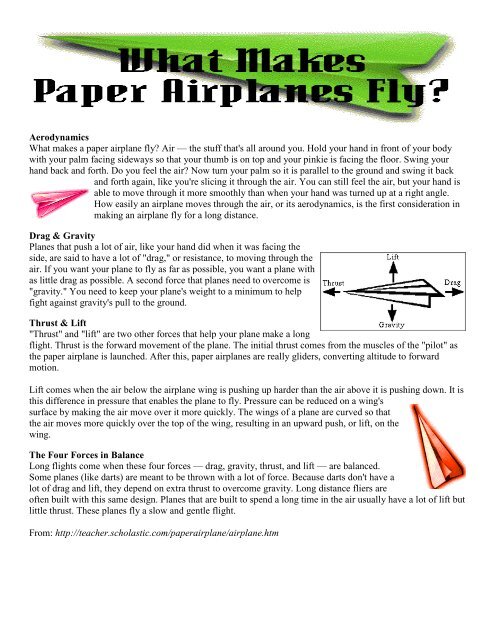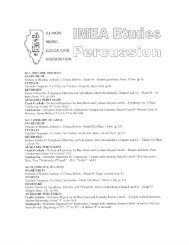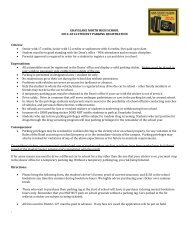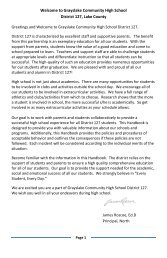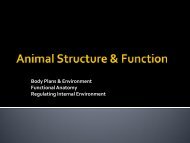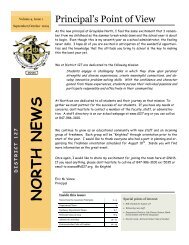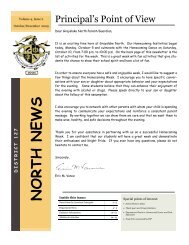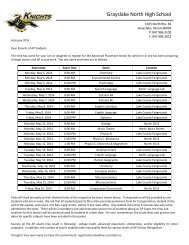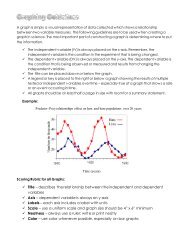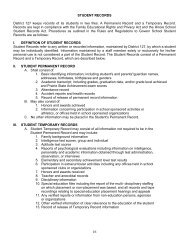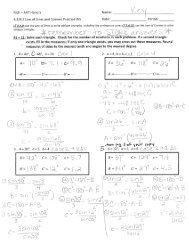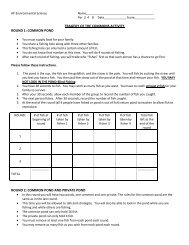Aerodynamics What makes a paper airplane fly? Air — the stuff ...
Aerodynamics What makes a paper airplane fly? Air — the stuff ...
Aerodynamics What makes a paper airplane fly? Air — the stuff ...
You also want an ePaper? Increase the reach of your titles
YUMPU automatically turns print PDFs into web optimized ePapers that Google loves.
<strong>Aerodynamics</strong><br />
<strong>What</strong> <strong>makes</strong> a <strong>paper</strong> <strong>airplane</strong> <strong>fly</strong>? <strong>Air</strong> <strong>—</strong> <strong>the</strong> <strong>stuff</strong> that's all around you. Hold your hand in front of your body<br />
with your palm facing sideways so that your thumb is on top and your pinkie is facing <strong>the</strong> floor. Swing your<br />
hand back and forth. Do you feel <strong>the</strong> air? Now turn your palm so it is parallel to <strong>the</strong> ground and swing it back<br />
and forth again, like you're slicing it through <strong>the</strong> air. You can still feel <strong>the</strong> air, but your hand is<br />
able to move through it more smoothly than when your hand was turned up at a right angle.<br />
How easily an <strong>airplane</strong> moves through <strong>the</strong> air, or its aerodynamics, is <strong>the</strong> first consideration in<br />
making an <strong>airplane</strong> <strong>fly</strong> for a long distance.<br />
Drag & Gravity<br />
Planes that push a lot of air, like your hand did when it was facing <strong>the</strong><br />
side, are said to have a lot of "drag," or resistance, to moving through <strong>the</strong><br />
air. If you want your plane to <strong>fly</strong> as far as possible, you want a plane with<br />
as little drag as possible. A second force that planes need to overcome is<br />
"gravity." You need to keep your plane's weight to a minimum to help<br />
fight against gravity's pull to <strong>the</strong> ground.<br />
Thrust & Lift<br />
"Thrust" and "lift" are two o<strong>the</strong>r forces that help your plane make a long<br />
flight. Thrust is <strong>the</strong> forward movement of <strong>the</strong> plane. The initial thrust comes from <strong>the</strong> muscles of <strong>the</strong> "pilot" as<br />
<strong>the</strong> <strong>paper</strong> <strong>airplane</strong> is launched. After this, <strong>paper</strong> <strong>airplane</strong>s are really gliders, converting altitude to forward<br />
motion.<br />
Lift comes when <strong>the</strong> air below <strong>the</strong> <strong>airplane</strong> wing is pushing up harder than <strong>the</strong> air above it is pushing down. It is<br />
this difference in pressure that enables <strong>the</strong> plane to <strong>fly</strong>. Pressure can be reduced on a wing's<br />
surface by making <strong>the</strong> air move over it more quickly. The wings of a plane are curved so that<br />
<strong>the</strong> air moves more quickly over <strong>the</strong> top of <strong>the</strong> wing, resulting in an upward push, or lift, on <strong>the</strong><br />
wing.<br />
The Four Forces in Balance<br />
Long flights come when <strong>the</strong>se four forces <strong>—</strong> drag, gravity, thrust, and lift <strong>—</strong> are balanced.<br />
Some planes (like darts) are meant to be thrown with a lot of force. Because darts don't have a<br />
lot of drag and lift, <strong>the</strong>y depend on extra thrust to overcome gravity. Long distance fliers are<br />
often built with this same design. Planes that are built to spend a long time in <strong>the</strong> air usually have a lot of lift but<br />
little thrust. These planes <strong>fly</strong> a slow and gentle flight.<br />
From: http://teacher.scholastic.com/<strong>paper</strong><strong>airplane</strong>/<strong>airplane</strong>.htm
How Does a Paper <strong>Air</strong>plane Fly?<br />
By Keith Evans,<br />
eHow Contributor<br />
A Paper <strong>Air</strong>plane is Designed with Wings<br />
1. When a <strong>paper</strong> <strong>airplane</strong> is designed, <strong>the</strong> builder folds <strong>the</strong> sheet of <strong>paper</strong> to provide maximum wingspan to<br />
support <strong>the</strong> plane for prolonged flight. As with general aviation, <strong>paper</strong> <strong>airplane</strong>s may be designed with<br />
different wing configurations for speed or lofty, prolonged flight. In addition, some designers choose to add<br />
a small weight to <strong>the</strong> plane to keep it stable in flight.<br />
The Plane Receives Thrust From <strong>the</strong> Thrower<br />
2. For any <strong>airplane</strong> to <strong>fly</strong>, it must have both thrust and lift. The wings provide lift for <strong>the</strong> <strong>airplane</strong> as described<br />
in Section 3 below, but <strong>the</strong> thrust must originate from outside <strong>the</strong> plane. As with any o<strong>the</strong>r form of aviation,<br />
<strong>the</strong> plane's lift overcomes <strong>the</strong> force of gravity and <strong>the</strong> plane's thrust must be enough to overcome <strong>the</strong> laws of<br />
inertia. When <strong>the</strong> <strong>paper</strong> <strong>airplane</strong> is thrown, it is thrown with enough force to overcome its tendency to<br />
remain still. Some people prefer to throw <strong>the</strong> plane at a slight upward angle to maximize <strong>the</strong> amount of time<br />
<strong>the</strong> plane moves forward (using thrust to move slightly upwards and gravity to continue moving). The angle<br />
at which <strong>the</strong> plane should be thrown is dependent on <strong>the</strong> plane's design.<br />
Wings Carry <strong>the</strong> Plane Through <strong>the</strong> <strong>Air</strong><br />
3. As <strong>the</strong> plane moves forward, its wings cut through <strong>the</strong> air to generate a small amount of lift. As <strong>the</strong> air<br />
rapidly flows over and under <strong>the</strong> <strong>paper</strong> wing, a tiny vacuum is formed over <strong>the</strong> top of <strong>the</strong> wing to hold <strong>the</strong><br />
plane aloft. As <strong>the</strong> forward motion diminishes, <strong>the</strong> airflow over <strong>the</strong> <strong>paper</strong> wing slows and <strong>the</strong> lift is reduced.<br />
As <strong>the</strong> thrust and lift subside, a properly designed <strong>paper</strong> <strong>airplane</strong> should glide to a safe landing.<br />
From: http://www.ehow.com/how-does_4567589_<strong>paper</strong>-<strong>airplane</strong>-<strong>fly</strong>.html
Fun Facts About Paper <strong>Air</strong>planes<br />
By Mary Flinn,<br />
eHow Contributor<br />
Paper <strong>airplane</strong>s have fascinated children and adults alike around <strong>the</strong> globe for generations. A simple toy to some, an aeronautics<br />
research tool to o<strong>the</strong>rs, <strong>paper</strong> <strong>airplane</strong>s can be folded into a variety of designs, from basic darts and gliders to intricate stunt<br />
planes and World War II <strong>airplane</strong>s. Turning <strong>paper</strong> into a <strong>fly</strong>ing machine may seem simple, but <strong>paper</strong> <strong>airplane</strong>s use <strong>the</strong> same<br />
principles of flight as <strong>airplane</strong>s. Whe<strong>the</strong>r <strong>the</strong>y are made to set a world record or design a better <strong>airplane</strong>, <strong>paper</strong> <strong>airplane</strong>s can be<br />
educational, interesting and fun.<br />
Inventor<br />
1. The invention of <strong>the</strong> <strong>paper</strong> <strong>airplane</strong> is mystery, but Leonardo Di Vinci is often given credit for <strong>the</strong> feat.<br />
Fun Fact<br />
2. According to <strong>the</strong> Paper <strong>Air</strong>craft Association, a <strong>paper</strong> <strong>airplane</strong> thrown in space will not <strong>fly</strong>; it will float in a<br />
straight line. Unless it hits an object, it could literally float forever (see Resources).<br />
Wingspan<br />
3. The record wingspan of a <strong>paper</strong> <strong>airplane</strong> is 40 feet and 10 inches. The craft flew over 114 feet before<br />
crashing into a wall.<br />
Education<br />
4. Scientists, engineers and students use <strong>paper</strong> <strong>airplane</strong>s to study aerodynamics. The National Aeronautics and<br />
Space Administration (NASA) sent a <strong>paper</strong> <strong>airplane</strong> to space on a space shuttle.<br />
Shapes<br />
5. Paper <strong>airplane</strong>s can be made in many shapes. According to world record holder Ken Blackburn, <strong>airplane</strong>s in<br />
<strong>the</strong> shape of an "X," a hoop and a "futuristic spacecraft" can all be made to <strong>fly</strong> (see Resources).<br />
Wea<strong>the</strong>r<br />
6. The humidity outside can affect <strong>the</strong> performance of a <strong>paper</strong> <strong>airplane</strong> thrown inside.<br />
From: http://www.ehow.com/facts_4967620_fun-facts-<strong>paper</strong>-<strong>airplane</strong>s.html


